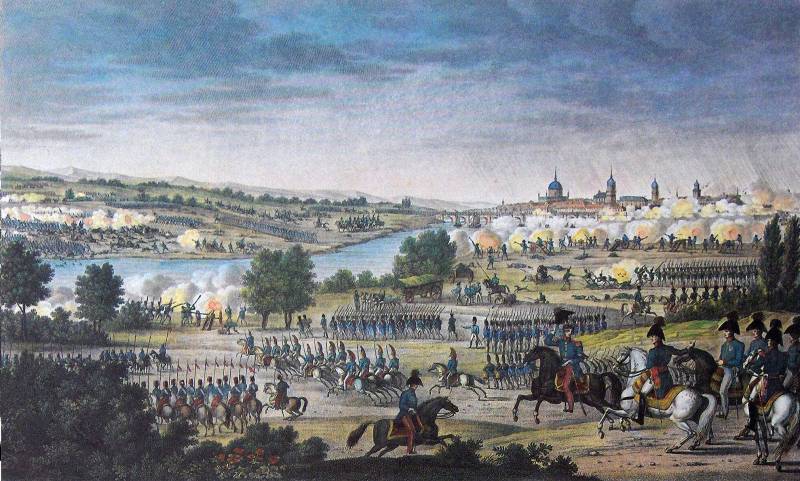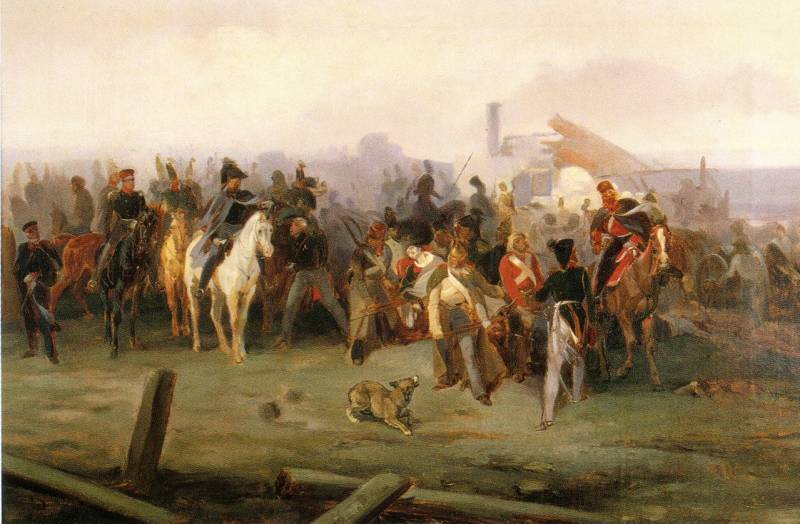Napoleon's victory in the battle of Dresden

French cuirassiers attack Allied positions on the heights around Dresden. XNUMXth century engraving.
Allied offensive
On August 11, 1813, the Austrian Empire declared war on France (“If you want war, well, we will fight!”). The Russian-Prussian army under the command of Mikhail Barclay de Tolly joined with the Austrians. The Bohemian (Southern) Army was led by Austrian Field Marshal Karl Philipp zu Schwarzenberg. But the Russian-Prussian army was led by Barclay, Tsar Alexander I interfered in military affairs.
Because of poor intelligence, Napoleon believed that the most powerful army of the allies was the central Silesian. In addition, Blucher was the first to start hostilities. Therefore, the French emperor moved the army to Blucher. Only the corps of Saint-Cyr remained in Dresden.
At this time, the army of Schwarzenberg, moving in four columns, launched an offensive from the south through the Ore Mountains to Leipzig. The allies were going to go to the flank and rear of the French army, which was advancing on the Silesian army. During the movement, the allies learned that the main enemy forces were not in Dresden. Two regiments of Westphalian hussars also went over to the Allied side, reporting on the Dresden defense system.
Therefore, it was decided to change the main goal of the offensive and capture Dresden. It was a large city, spread out on both banks of the Elbe River. Dresden was the central supply hub for the French army in Central Europe. It contained significant stocks of provisions and ammunition. The city had a weak defense: a dilapidated wall and several redoubts with artillery batteries installed on them. Bonaparte was not going to defend himself.
Napoleon, having learned about the dangerous movement and maneuver of the enemy, immediately turned back. At first, he wanted to go behind the lines of the allied army, moving towards Pirna. But, having received news of the possibility of the fall of Dresden, he sent the main forces to the city. Movement behind enemy lines was continued only by Vandam's 1st Corps. Against the Silesian army, the emperor left MacDonald's group with three infantry and one cavalry corps.
If the Vandam Corps could implement the plan conceived by the French emperor, then the allied army would be threatened with complete encirclement and destruction (or surrender). The French exit to Teplitz blocked the allies' narrow passage through the Ore Mountains, which threatened a military catastrophe. The presence of the Russian tsar and the Prussian king in the Bohemian army worsened the situation. They would have had to negotiate, to make big concessions in order to avoid a catastrophe. And the Austrians were traditionally cunning, conducted behind-the-scenes negotiations with the French, and in such a scenario they could withdraw from the Sixth Anti-French Coalition.

Correlation of forces
The size of the allied army is estimated at 170-230 thousand people. But the last figure is given on the basis of the regular number of corps and divisions, and it could be very different from the actual one. The armies suffered heavy losses not from fighting, but from marches on bad roads, lack of food, mass diseases and desertion. In general, the allies outnumbered the enemy in the number of soldiers, artillery and cavalry. There were also many experienced soldiers. Napoleon's army was dominated by recruits.
Dresden was defended by the garrison and the 14th Corps under the command of Marshal Saint-Cyr, only about 30 thousand people with 70 guns. Under the leadership of Napoleon there were about 120 thousand people. But during the marches, the ranks of the corps thinned out significantly. From this army, the Vandam Corps was singled out - about 35 thousand soldiers.

Austrian Field Marshal, Commander of the Bohemian Army Carl Philipp zu Schwarzenberg
missed opportunity
On August 13 (25), 1813, the forward formations of the allied army approached the city. The Russian and Prussian corps under the command of Wittgenstein and Kleist, as well as the Austrian corps of Colloredo-Mansfeld, came to Dresden. The allied command, in order to ensure the rear from Königstein, sent a detachment of Gelfreich to this area. If necessary, he was to be reinforced by the 2nd Infantry Corps of the Prince of Württemberg.
The French occupied field fortifications in front of the city suburbs. Saint-Cyr had three French divisions - the 43rd, 44th and 45th (42nd remained with Königstein), three Westphalian regiments and several thousand allied troops (Dutch, Polish, Saxon, Baden). Most of Saint-Cyr's corps consisted of recruits with no combat experience. The 43rd division of Claparede defended the territory from the left bank of the Elbe to the Freiberg outpost, occupying the Gross Garten (Big Garden); 44th division of Bertezen - Pirnsky suburb; 45th Razu Division - Friedrichstadt.
The allies already had 70-80 thousand soldiers, and more and more formations approached the city. General Jomini suggested an immediate attack. That would be Suvorov. This was one of Napoleon's talented commanders, offended by the fact that he was not promoted to divisional generals after the victory at Bautzen, where he distinguished himself. As a result, Jomini went over to the side of the allied army, became an adviser to Tsar Alexander.
Moreau opposed, believing that the assault would lead to heavy losses and be repulsed. Alexander I doubted. The Austrians were also cautious, they offered to wait for the approach of all forces. First completely surround the city and only then go on the attack. As a result, the Allies missed the opportunity to defeat the relatively weak corps of Saint-Cyr.
Meanwhile, Bonaparte's army reached the fork in the road leading to the city and the bridge on the left bank of the Elbe in the Königstein area. Königstein was 27 km southeast of Dresden. The emperor sent his general Gaspard Gurgaud to Dresden to clarify the situation. Napoleon's adjutant returned at 11 pm with a report that Dresden, in the event of a general assault by the Bohemian army, would last no more than a day. When crossing at Königstein, the enemy needed at least 2–3 days to march to the rear. The emperor led the main forces to Dresden, sent only the 1st corps around.

Battle of Dresden. Color lithograph by A. Bern
Allies attack
The allies attacked the city with 5 columns, but they attacked at different times, without communication. The 1st column on the right flank near the Elbe was Wittgenstein's troops, they advanced in an auxiliary direction. The 2nd column in the center was made up of Prussian troops. The Prussians were to capture the Gross Garten and advance further. The remaining columns on the left flank were Austrians - the 1st Light Division, the 3rd Reserve Division, the Bianchi Division, the Schneller Division. The Austrian reserve included the grenadier division of Schatler, the divisions of Nostitz and Lederer.
According to the plan drawn up at night, all troops were supposed to launch an offensive at 16:00, but not all units received a disposition. Therefore, in the morning, the Austrians and Prussians began to move, and the Russians - according to the plan at 16 o'clock. The location of the main impact was not determined. It was believed that it was enough to take the suburbs, and the enemy would throw out a white flag.
The offensive of the Austrians developed sluggishly. They didn’t prepare for the assault, they didn’t prepare fascines and ladders. By 17 o'clock the Austrians were able to take only two redoubts and a few cannons, reaching the city wall. The Prussians acted more decisively, drove the enemy out of the Great Garden and went out to the central fortifications. Russian troops have just begun the attack. They came under crossfire from city redoubts and enemy batteries from the right bank of the Elbe. The passivity of the Austrians, disorder, lack of interaction allowed the French to hold back the first onslaught of the enemy.
French counteroffensive
By the end of the day, Napoleon's troops approached the city. The great Frenchman did not become cautious and immediately led the troops on the attack. The French troops delivered a series of blows, forcing the allied army to go on the defensive, despite its numerical and qualitative superiority. The Prussians were pushed back to Strehlen. Murat's young guards and cavalry drove the Austrians away from the city. The offensive of the Russian troops was stopped by the counterattacks of the French cavalry. In addition, the command order to stop the assault finally reached the troops. As a result, the Bohemian army rolled back along the entire front to the heights surrounding Dresden. By 21 o'clock the battle had ceased.
At night, Victor's 2nd Corps and Marmont's 6th Corps headed for Dresden. Bonaparte decided to continue the offensive. The southern Allied army took up a defensive position in a semicircle near Dresden. Its strongest part of the defense was the center, located on the heights. Napoleon decided to strike the main blows on the flanks. The attack on the left flank was facilitated by the fact that part of the Austrian troops - the Gyulai corps with part of the Klenau corps - were separated from the main forces by the Vaiseritz river. The French, with success, could cut off the enemy from the best escape routes - they were located on the flanks. On the right flank (Russian) the road led along the Elbe to Pirna, on the left (Austrian) to Freiberg. The paths that passed through the center of the Bohemian army were secondary.
At 7 am on August 27, the French troops went on the attack. The left flank was attacked by Viktor's infantry and Murat's cavalry. The corps of Ney, Saint-Cyr and the Young Guard hit the right flank - the Russian-Prussian troops. The center covered the corps of Marmont. In reserve was the Old Guard. The battle was accompanied by heavy rain, and the soldiers could not conduct effective rifle fire. Artillery and cavalry played the main role in the battle.
Having tied up the main forces of the Austrian army at the front, the French cavalry broke through the left flank of the Austrians. Liechtenstein's division, desperately fighting back and suffering heavy losses, was able to force Weiseritz and break through to their own. Mechko's division was surrounded. The Austrians lined up in a square and, under the attacks of the French cavalry and artillery fire from horse batteries, began to retreat. The Austrians were pressed against the river and, under the threat of complete destruction, they laid down weapon.
As a result, the left flank of the Austrians was completely defeated. The Austrian army lost up to 15 thousand people, including 10 thousand prisoners.
Retreat
On the right flank, the Russian troops withdrew from the Elbe, but, having gained a foothold on the heights, repelled enemy attacks. The allied army still had enough strength to fight. The Russian tsar and the Prussian king wanted to counterattack on the right flank with the forces of the Prussians Kleist, the cavalry reserve and the Russian guard (she was in reserve). The commander of the Russian-Prussian army Barclay was against such an attack.
The Austrians were demoralized by the defeat of their left flank. Schwarzenberg and his staff suggested leaving immediately for Bohemia. The allied monarchs were against the withdrawal. The Prussian king believed that the next day it was necessary to continue the battle, since most of the allied army had not even fought yet. Russian-Prussian troops remained combat-ready and wanted to fight. Jomini offered to change position and continue the fight.
The Austrians insisted on a retreat. At 17 p.m., the Allies began to withdraw. The retreat was covered by the Russian rearguard of Osterman-Tolstoy. Napoleon did not immediately realize that the enemy was leaving. He decided that the battle would continue the next day. When it became clear that the enemy was retreating, the ensuing darkness and the general fatigue of the troops did not allow the immediate pursuit to be organized. In addition, the French did not have enough cavalry. Therefore, the Bohemian army successfully withdrew, entrenched itself in the Ore Mountains, and in early September 1813 went on a new offensive.
The allied army lost 20-28 thousand people (half were prisoners), 22 guns. Almost all the prisoners were Austrians.
The Russian army lost 1 men, including two brave major generals, Fyodor Lukov, commander of the Sevsk Infantry Regiment, and Aleksey Melissino (a Russian of Greek origin), commander of a cavalry brigade. In the same battle, the advisor to the Russian Tsar, French General Jean Victor Moreau, also received a mortal wound. Moreau and Alexander I on horseback stood on one of the heights and came under artillery fire. The general's right leg was torn off and his left knee crushed. After the amputation, he was seriously ill and died on September 300.
The French army lost 9-12 thousand people.
The defeat was caused by the lack of unity of command among the allies, disagreements between the commanders, and the indecision of the Austrians. The Allies did not have a commander-in-chief of the level of Suvorov or Napoleon to use their common advantage and defeat the enemy. They could well, with a decisive offensive, defeat Saint-Cyr, occupy the city, and then push Napoleon back. A whole day was lost (August 25), and on August 26 the Allies acted separately, as three separate armies.
As a result, Napoleon immediately seized the initiative and took over the stronger enemy army. However, the French again failed to develop success and put the squeeze on the enemy. The allies retreated harmoniously, retained their combat capability and almost all of their artillery.

Mortal wound Moro. Artist Gottfried Julius Scholz
Information